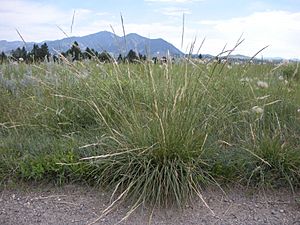Green needlegrass facts for kids
Quick facts for kids Green needlegrass |
|
|---|---|
 |
|
| Conservation status | |
| Scientific classification | |
| Genus: |
Nassella
|
| Species: |
viridula
|
| Synonyms | |
|
Stipa viridula |
|
Nassella viridula, commonly called green needlegrass, is a type of grass. It grows naturally in North America. You can find it across western Canada and the western and central United States. It has also spread to some parts of eastern North America.
Contents
Green Needlegrass: A Tough Plant
What Does It Look Like?
This grass grows in clumps or "tufts." Its stems can reach up to about 1.2 meters (nearly 4 feet) tall. It has strong roots that can go deep into the soil. These roots sometimes go over 1.5 meters (5 feet) down! Most of its leaves grow from the base of the plant. Each leaf can be up to 30 centimeters (about 1 foot) long. They get very thin at the tip, like a thread. The plant also has special parts called spikelets. These have long, thin bristles called awns. These awns can be almost 4 centimeters long and are bent twice.
How Does It Reproduce?
Green needlegrass makes new plants in two ways. It grows from seeds. It also grows new shoots from its base. This is called tillering. The seeds might "sleep" for a while before growing. Sometimes, they need a cold period to help them sprout. This process is called stratification.
Where Does It Grow?
You can find this grass in many different places. It grows well in areas that have been disturbed. Here, it acts as a pioneer species. This means it is one of the first plants to grow back. In some areas, like North Dakota, it is a climax species. This means it is a main plant in a stable ecosystem. Green needlegrass is often a dominant plant. It is also an indicator species. This means its presence tells us about the habitat. It can handle many different temperatures. It also does well when there is not much water, meaning it is drought-tolerant.
Why Is It Important?
Many animals use green needlegrass for food and shelter. Many waterfowl (like ducks and geese) and other birds build their nests in this grass.


